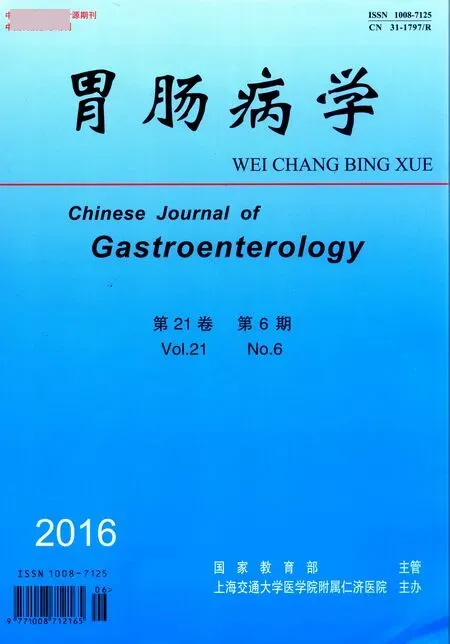盘状结构域受体1在消化系统肿瘤中的表达及其意义
杨佳纯 孟燕旎 徐雷鸣
上海交通大学医学院附属新华医院消化内科(200092)
盘状结构域受体1在消化系统肿瘤中的表达及其意义
杨佳纯孟燕旎徐雷鸣*
上海交通大学医学院附属新华医院消化内科(200092)
摘要盘状结构域受体1(DDR1)作为一种受体酪氨酸激酶(RTKs)在诸多肿瘤中表达异常,参与肿瘤的生长、浸润、转移等过程,有望成为肿瘤治疗的潜在目标。本文就DDR1在消化系统肿瘤中的表达及其意义作一综述。
关键词盘状结构域受体1;消化系统肿瘤;肿瘤侵袭;肿瘤转移;受体蛋白质酪氨酸激酶类;治疗
Neoplasm Metastasis;Receptor Protein-Tyrosine Kinases;Therapy
受体酪氨酸激酶(receptor tyrosine kinases, RTKs)属于单次跨膜蛋白,与相应配体结合后激活磷酸化,通过一系列信号转导途径,调控细胞的综合性应答。诸多研究表明,盘状结构域受体1(DDR1)作为一种新型RTKs家族成员,对肿瘤的发生、发展起着至关重要的作用,有望成为肿瘤治疗的潜在目标[1]。本文就DDR1在消化系统肿瘤中的表达及其意义作一综述。
一、DDR1的结构和亚型
DDR1由3个部分组成,即含有配体结合位点的胞外区、跨膜区以及可发生酪氨酸磷酸化的胞内激酶区。与其他RTKs家族成员相比,DDR1不仅在胞外结构域上存在1个含有160个氨基酸残基的盘状结构域(DR区),亦在DR区与跨膜区间存在一个邻跨膜区(JM区)[2]。研究发现,DR区可与不同类型的胶原蛋白特异性结合,促进肿瘤的迁移和侵袭[3]。JM区则可能具有协同限制的功能,有利于激酶区与底物发生反应[4]。
DDR1主要表达于上皮细胞,可与纤维和基底胶原蛋白相互作用[5-6]。DDR1 基因包含17 个外显子,后者经选择性剪接后产生5种不同亚型,分别为DDR1a、DDR1b、DDR1c、DDR1d以及DDR1e。选择性剪切外显子10~12可产生a亚型和b亚型,其中a亚型缺失外显子11;相对于b亚型,c亚型在外显子14的内含子/外显子边缘插入了1个18 bp的开放阅读框(ORF)[7];d亚型因缺失外显子11和12导致移码突变和翻译提前中止;e亚型除缺失外显子10的前半部分,亦缺失外显子11和12[8]。目前研究显示,DDR1b主要在胚胎发育过程中表达,DDR1a则异常表达于某些肿瘤细胞。DDR1d和DDR1e因ATP结合位点缺失而失活,尚无明确生物学功能[2]。
二、DDR1的作用机制
1. DDR1对肿瘤细胞增殖、凋亡的调节:研究[9]发现DDR1作为p53作用靶点参与DNA修复。当DNA损伤时,p53激活DDR1磷酸化,通过Ras-Raf-MAPK和AKT信号通路参与调节细胞存活和凋亡。DDR1亦可与Notch1直接作用,使Notch1产生构象变化,利用γ-分泌酶进行一系列溶蛋白性裂解反应,释放Notch1受体胞内区,从而调控细胞增殖[10]。对核因子(NF)-κB信号通路研究[11]发现,DDR1可通过IκB激酶β(IKKβ)和IKKγ介导环氧合酶(COX)-2表达,延长细胞存活时间。对人胰腺癌BxPC-3细胞研究[12]显示,DDR1可通过与下游信号分子转化生长因子β诱导蛋白(TGFβI)相互作用,促进细胞生长。
2. DDR1对肿瘤细胞侵袭、转移的调节:DDR1与肿瘤细胞侵袭和转移关系密切,可通过蛋白水解酶抑制肌动球蛋白收缩,改变细胞间的连接方式,从而促进细胞侵袭和转移[13]。DDR1可与Ⅰ型胶原蛋白相互作用,通过活化细胞分裂周期蛋白Cdc42,招募侵袭伪足形成相关分子,如神经元Wiskott-Aldrich综合征蛋白(N-WASP)、皮层蛋白、支架蛋白Tks5等,形成线性侵袭体,诱导膜型1-基质金属蛋白酶(MT1-MMP)和MMP-2分泌,降解细胞外基质,促进侵袭发生[14]。DDR1亦可通过调控上皮-间质转化(EMT)过程,使癌细胞失去极性,获得较高的转移和侵袭能力,脱离原发部位,向远处转移[15-16]。然而,进一步研究发现,DDR1并非在所有肿瘤的侵袭、转移过程中均发挥促进作用。Koh等[17]的研究发现,在三阴性乳腺癌中,抑制E-钙黏蛋白(E-cad)和DDR1表达可介导EMT发生。因此,DDR1在不同肿瘤细胞中的作用有所差异,可能由涉及的信号通路不同所致。
三、DDR1在消化系统肿瘤中的表达
1. DDR1与肝癌:对肝癌细胞株HLE、Huh-7、HepG2的研究[18]显示,DDR1在三种细胞株中均有表达,Ⅰ 型胶原蛋白可通过诱导酪氨酸磷酸化激活DDR1,调控MMP-2和MMP-9表达,从而促进肝癌细胞侵袭和转移。下调miR-199a-5p表达可降低由DDR1诱导的肝癌细胞迁移和侵袭能力[19]。对临床资料的研究[20]发现,在不同复发倾向的肝癌组织中,DDR1阳性表达率在早期复发的肝癌组织中显著升高,与患者性别、年龄、肿瘤大小、Edmonson分级无关,仅与早期复发存在密切相关,提示DDR1表达与肝癌进展和预后具有一定联系。
2. DDR1与胰腺癌:Couvelard 等[21]的研究显示,DDR1异常表达于恶性胰腺内分泌肿瘤。Shintani等[22]对胰腺癌细胞株BxPC-3研究发现,DDR1和整合素α2β1可通过独立的信号转导途径上调N-cad,作用于Ⅰ型胶原蛋白,促进肿瘤细胞侵袭和转移。此外,Clementz等[16]的研究发现,在胰腺癌细胞EMT过程中,ⅩⅤ型胶原蛋白通过直接作用于DDR1抑制其通路,稳定E-cad表达,使肿瘤细胞保持上皮细胞表型,下调N-cad,抑制Ⅰ型胶原蛋白诱导EMT发生,从而阻止肿瘤细胞扩散。由此可见,DDR1在胰腺癌中的作用与胶原蛋白密切相关,两者通过多种信号途径相互作用,从而诱导肿瘤细胞迁移和转移。
3. DDR1与结肠癌:何苗等[23]的研究显示,DDR1a高表达于结肠癌细胞株,且与MMP-2和MMP-9活性呈正相关。进一步研究[24]发现,DDR1各亚型在不同结肠癌细胞株中的表达不同。DDR1a和DDR1b在结肠癌细胞株Colo678、Colo320、SW48和HCT116中相对高表达,在WiDr、Colo205和Caco2中相对低表达,在Colo206F细胞中甚至不表达DDR1a和DDR1b,仅表达DDR1d和DDR1e。推测在不同微环境中,不同肿瘤的发生、发展可能受DDR1不同亚型调控。
4. DDR1与其他消化系统肿瘤:Nemoto等[25]的研究显示,DDR1在食管癌尤其在浸润性病灶和淋巴结转移组织中表达增高。李超等[26]通过多因素分析表明,DDR1阳性表达率和TNM分期均为食管鳞癌预后的独立危险因素。余建杰等[27]的研究表明,DDR1a在胃癌组织中的阳性表达率显著高于癌旁正常组织,尤其在Ⅲ~Ⅳ期、直径大于5 cm、伴有淋巴结转移的胃癌组织中,DDR1a表达显著增高。Gu等[28]的研究显示,与癌旁组织相比,胆管细胞癌组织中DDR1表达高磷酸化水平,可能与诱导癌细胞转化相关。上述研究虽已表明DDR1在多种恶性肿瘤中异常表达,但具体作用机制仍有待进一步研究证实。
四、DDR1在肿瘤中的治疗
Kim等[29]发现了一种选择性DDR1抑制剂DDR1-IN-1,其可与“DFG-out”(DFG,Asp-Phe-Gly)构象结合,抑制DDR1自身磷酸化。该研究团队进一步对结肠癌细胞研究发现,PI3K/mTOR双抑制剂GSK2126458可明显增强DDR1-IN-1对癌细胞的抗增殖能力。因此认为DDR1-IN-1可针对性地作用于DDR1,有望成为DDR1过表达或突变的肿瘤治疗探针。Elkamhawy等[30]的研究发现,含有喹唑啉的KST9046能通过构象改变,选择性地抑制DDR1激酶,从而抑制肿瘤细胞增殖,该研究提出KST9046有望成为安全有效的抗癌药物用于肿瘤治疗。
五、结语
DDR1作为一种RTKs在诸多消化系统肿瘤中表达异常,通过多种信号途径与胶原蛋白相互作用,参与肿瘤的生长、浸润、转移等过程。目前已发现针对DDR1作用的选择性抑制剂,但治疗效果尚未明确,有待进一步行动物实验和临床试验证实,明确其在肿瘤治疗方面的作用机制和临床效果,为抗肿瘤药物和肿瘤联合治疗的研究提供新方向。此外,由于DDR1分为5种亚型,应明确不同消化道肿瘤的DDR1亚型,了解各种亚型在不同肿瘤中的致癌机制,从而有助于肿瘤抑制剂的研制,并为肿瘤的基因治疗、靶向治疗提供新线索。
参考文献
1 Leitinger B. Discoidin domain receptor functions in physiological and pathological conditions[J]. Int Rev Cell Mol Biol, 2014, 310: 39-87.
2 Valiathan RR, Marco M, Leitinger B, et al. Discoidin domain receptor tyrosine kinases: new players in cancer progression[J]. Cancer Metastasis Rev, 2012, 31 (1-2): 295-321.
3 Leitinger B. Transmembrane collagen receptors[J]. Annu Rev Cell Dev Biol, 2011, 27: 265-290.
4 Johnson JD, Edman JC, Rutter WJ. A receptor tyrosine kinase found in breast carcinoma cells has an extracellular discoidin Ⅰ-like domain[J]. Proc Natl Acad Sci U S A, 1993, 90 (22): 10891.
5 Maeyama M, Koga H, Selvendiran K, et al. Switching in discoid domain receptor expressions in SLUG-induced epithelial-mesenchymal transition[J]. Cancer, 2008, 113 (10): 2823-2831.
6 Carafoli F, Hohenester E. Collagen recognition and transmembrane signalling by discoidin domain receptors[J]. Biochim Biophys Acta, 2013, 1834 (10): 2187-2194.
7 Playford MP, Butler RJ, Wang XC, et al. The genomic structure of discoidin receptor tyrosine kinase[J]. Genome Res, 1996, 6 (7): 620-627.
8 Alves F, Saupe S, Ledwon M, et al. Identification of two novel, kinase-deficient variants of discoidin domain receptor 1: differential expression in human colon cancer cell lines[J]. FASEB J, 2001, 15 (7): 1321-1323.
9 Ongusaha PP, Kim JI, Fang L, et al. p53 induction and activation of DDR1 kinase counteract p53-mediated apoptosis and influence p53 regulation through a positive feedback loop[J]. Embo J, 2003, 22 (6): 1289-1301.
10Kim HG, Hwang SY, Aaronson SA, et al. DDR1 receptor tyrosine kinase promotes prosurvival pathway through Notch1 activation[J]. J Biol Chem, 2011, 286 (20): 17672-17681.
11Das S, Ongusaha PP, Yang YS, et al. Discoidin domain receptor 1 receptor tyrosine kinase induces cyclooxygenase-2 and promotes chemoresistance through nuclear factor-kappaB pathway activation[J]. Cancer Res, 2006, 66 (16): 8123-8130.
12Rudra-Ganguly N, Lowe C, Mattie M, et al. Discoidin domain receptor 1 contributes to tumorigenesis through modulation of TGFBI expression[J]. PLoS One, 2014, 9 (11): e111515.
13Hidalgo-Carcedo C, Hooper S, Chaudhry SI, et al. Collective cell migration requires suppression of actomyosin at cell-cell contacts mediated by DDR1 and the cell polarity regulators Par3 and Par6[J]. Nat Cell Biol, 2011, 13 (1): 49-58.
14Juin A, Di Martino J, Leitinger B, et al. Discoidin domain receptor 1 controls linear invadosome formation via a Cdc42-Tuba pathway[J]. J Cell Biol, 2014, 207 (4): 517-533.
15Miao L, Zhu S, Wang Y, et al. Discoidin domain receptor 1 is associated with poor prognosis of non-small cell lung cancer and promotes cell invasion via epithelial-to-mesenchymal transition[J]. Med Oncol, 2013, 30 (3): 626.
16Clementz AG, Mutolo MJ, Leir SH, et al. Collagen ⅩⅤ inhibits epithelial to mesenchymal transition in pancreatic adenocarcinoma cells[J]. PLoS One, 2013, 8 (8): e72250.
17Koh M, Woo Y, Valiathan RR, et al. Discoidin domain receptor 1 is a novel transcriptional target of ZEB1 in breast epithelial cells undergoing H-Ras-induced epithelial to mesenchymal transition[J]. Int J Cancer, 2015, 136 (6): E508-E520.
18Park HS, Kim KR, Lee HJ, et al. Overexpression of discoidin domain receptor 1 increases the migration and invasion of hepatocellular carcinoma cells in association with matrix metalloproteinase[J]. Oncol Rep, 2007, 18 (6): 1435-1441.
19Shen Q, Cicinnati VR, Zhang X, et al. Role of microRNA-199a-5p and discoidin domain receptor 1 in human hepatocellular carcinoma invasion[J]. Mol Cancer, 2010, 9: 227.
20Jian ZX, Sun J, Chen W, et al. Involvement of discoidin domain 1 receptor in recurrence of hepatocellular carcinoma by genome-wide analysis[J]. Med Oncol, 2012, 29 (5): 3077-3082.
21Couvelard A, Hu J, Steers G, et al. Identification of potential therapeutic targets by gene-expression profiling in pancreatic endocrine tumors[J]. Gastroenterology, 2006, 131 (5): 1597-1610.
22Shintani Y, Fukumoto Y, Chaika N, et al. Collagen Ⅰ-mediated up-regulation of N-cadherin requires cooperative signals from integrins and discoidin domain receptor 1[J]. J Cell Biol, 2008, 180 (6): 1277-1289.
23何苗,傅仲学. DDR1a在结肠癌细胞株中的表达及与基质金属蛋白酶2,9的关系[J]. 重庆医科大学学报, 2009, 34 (2): 161-163.
24何苗. DDR1蛋白组关于结肠癌细胞侵袭力的探讨[D]. 重庆: 重庆医科大学, 2008.
25Nemoto T, Ohashi K, Akashi T, et al. Overexpression of protein tyrosine kinases in human esophageal cancer[J]. Pathobiology, 1997, 65 (4): 195-203.
26李超,陈力,沈学远. 人食管鳞癌组织中DDR1表达及预后意义[J]. 中国现代医学杂志, 2014, 24 (4): 30-33.
27余建杰,魏丽娜,董驰,等. 胃癌组织DDR1a表达临床意义分析[J]. 中国肿瘤防治杂志, 2012, 19 (14): 1074-1077.
28Gu TL, Deng X, Huang F, et al. Survey of tyrosine kinase signaling reveals ROS kinase fusions in human cholangiocarcinoma[J]. PLoS One, 2011, 6 (1): e15640.
29Kim HG, Tan L, Weisberg EL, et al. Discovery of a potent and selective DDR1 receptor tyrosine kinase inhibitor[J]. ACS Chem Biol, 2013, 8 (10): 2145-2150.
30Elkamhawy A, Park JE, Cho NC, et al. Discovery of a broad spectrum antiproliferative agent with selectivity for DDR1 kinase: cell line-based assay, kinase panel, molecular docking, and toxicity studies[J]. J Enzyme Inhib Med Chem, 2016, 31 (1): 158-166.
(2015-07-07收稿;2015-07-28修回)
DOI:10.3969/j.issn.1008-7125.2016.06.011
Expression and Significance of Discoidin Domain Receptor 1 in Tumors of Digestive System
YANGJiachun,MENGYanni,XULeiming.
DepartmentofGastroenterology,XinHuaHospitalAffiliatedtoShanghaiJiaoTongUniversitySchoolofMedicine,Shanghai(200092)
Correspondence to: XU Leiming, Email: leiming.xu@aliyun.com
AbstractDiscoidin domain receptor 1(DDR1)is a kind of receptor tyrosine kinases (RTKs), which is expressed abnormally in many tumors. It is involved in the development, invasion and metastasis process of tumors and may become a potential target of tumor therapy. This article reviewed the expression and significance of DDR1 in tumors of digestive system.
Key wordsDiscoidin Domain Receptor 1;Digestive System Neoplasms;Neoplasm Invasiveness;
*本文通信作者,Email: leiming.xu@aliyun.com

